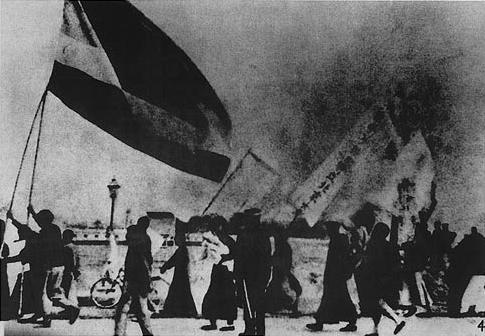by Brian Hioe
語言:
English
Photo Credit: Chen Chien-jen/Facebook
I REMEMBER being amused a few years ago during the one-hundredth year anniversary of the May 4th Movement, when members of the pan-Blue camp, along with various Chinese nationalists, were outraged by the Tsai administration instead commemorating the date as “May the Fourth be with You”—Star Wars Day, I guess you could call it.
For what it’s worth, probably more people the world over have heard of Star Wars than they have the May 4th Movement. But the May 4th Movement was a truly world-historic event, as one of the seminal moments in the founding of modern China. The movement originated from student movements against unequal conditions signed by the then-ruling Chinese government, the Republic of China (ROC), in the Treaty of Versailles.

Then-Taiwanese vice president Chen Chien-jen on May 4th, 2019. Photo credit: Chen Chien-jen/Facebook
The ROC later wound up in Taiwan; the KMT brought it over with them when they fled to Taiwan following their defeat to the Chinese Communist Party during the Chinese Civil War. KMT party leaders such as Sun Yat-sen and Chiang Kai-shek were, in fact, critical of the May 4th movement, seeing as it was a demonstration against the actions of the government they led.
The KMT’s relation to the May 4th movement has been tenuous. When the KMT came to Taiwan, on the heels of the fifty-year Japanese colonial period, they sought to capitalize on May 4th movement figures such as writer Lu Xun, as a means of “re-Sinicizing” Taiwan. But Lu Xun’s work encouraged criticisms of the government—any government—contributing to political dissent against the KMT’s authoritarian rule. That later led the KMT to remove Lu Xun from the curriculum and try to crack down on his work.
But, in the present, both the KMT and the CCP commemorate the May 4th Movement as part of the official narratives of their party history. Members of the pan-Blue camp were up in arms over a controversy regarding the choice of the president of National Taiwan University, Taiwan’s most prestigious university, several years ago; they claimed that was a “New May 4th Movement.” Ironically, despite valuating May 4th, the CCP, too, has sometimes faced similar issues regarding how May 4th thinkers as Lu Xun encouraged political criticism—this has led to their removal from contemporary textbooks in a period in which China has again lurched toward political authoritarianism under Xi Jinping.

Students demonstrating in Beijing on May 4th, 1919
Of course, for the historically independence-leaning DPP, the May 4th movement is something that occurred in a different country and which has little to do with Taiwan. This explains the Tsai administration’s greater interest in celebrating “May the Fourth be With You” than the May 4th Movement. This is why there would be outraged reactions from the KMT and Chinese nationalists across the straits that the Tsai administration cared more for a western science fiction franchise than a key moment in the history of modern China. Funnily enough, this in itself is another way that Taiwan differs from China—Star Wars never caught on in China and the new Disney films have floundered, seeing as audiences there didn’t have decades of nostalgia for the franchise.
This year, the KMT’s current chair, Johnny Chiang, tried to take a middle-of-the-ground approach. In an English-language tweet, Chiang began by referencing the Star Wars May 4th, but then attempting to link that back to the May 4th Movement.
#MayThe4th isn’t just #StarWarsDay! 102 years ago today, Chinese intellectuals, frustrated with the injust results of the Paris Peace Conference, stood up against the warlord-run gov’t.
On #May4th, democratic patriotism and a scientific culture were born in the #RepublicOfChina!
— 江啟臣|JOHNNY CHIANG (@JohnnyChiang12) May 4, 2021
Tweet by Johnny Chiang
Chiang originally took power as KMT chair in March 2020, promising to reform the party to change its pro-China image and win back the support of young people. Still, Chiang has faced steep opposition from traditionalists that see him as compromising too much on the party’s historic values—this explains Chiang’s odd tweet attempting to link the two May 4ths.
Still, this perhaps does, in fact, boil down to a choice in values. During the May 4th movement, there was a flourishing of literature and the arts—including fanciful Chinese science fiction that drew inspiration from western science fiction, but was also highly unique and innovative in its own right. In this way, the May 4th movement sought to provide an imaginative vision for what a future China could look like—much as the Star Wars franchise has an imaginative vision of the future, even if the newer films are somewhat cynical attempts at cashing in on nostalgia and the franchise itself frames itself as set in the past.
Today, however, in invoking May 4th, the KMT simply attempts to try and yoke Taiwan’s future to a distant, remote past, one which has little to do with contemporary Taiwan— with about as little inherent relation with Taiwan as Star Wars. Yet the Star Wars franchise was highly shaped by the Cold War, with the framing of the plucky Rebel Alliance as America and other western powers versus the authoritarian, menacing and faceless Empire—clearly a stand-in for the USSR. This draws a strange resonances with Taiwan, perhaps, given how the island nation’s 20th century history has been strongly shaped by the Cold War. Further irony, then, regarding the intersection of the two May 4ths.



